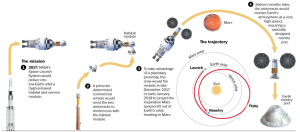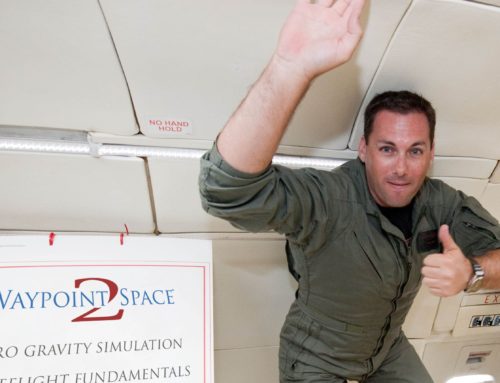Billionaire Dennis Tito, tired of being told that we can’t send humans to Mars just yet, on Wednesday revealed his scheme for launching two astronauts to the red planet as early as December 2017.
Dubbed “Inspiration Mars,” the flyby mission would exploit a rare alignment of Earth and Mars that minimizes the time and the fuel it would take to get to Mars and back home again. The astronauts would come within 100 miles of the Martian surface before being slung back to Earth.
“It would be a voyage of around 800 million miles around the sun in 501 days,” Tito testified Wednesday at a hearing of the House subcommittee on space. “No longer is a Mars flyby mission just one more theoretical idea. It can be done. Not in a matter of decades, but in a few years.”
Tito is a former engineer who made a fortune in investment management and, in 2001, became the first person to pay his way into space, buying a seat on a Russian rocket. Now he’s pitching Inspiration Mars as a national priority for the United States. Grab this rare chance to go to Mars quickly or risk seeing China or Russia get there first, he told members of Congress.
Tito mentioned a backup plan that would offer Inspiration Mars four more years of development time. Another alignment of planets in 2021 offers a second chance to go to Mars fairly quickly, but the journey would last 80 days longer and require that the astronauts fly much closer to the sun, within the orbit of Venus, in one portion of the trip. That would add to the already considerable radiation hazards.
When Tito broached the idea of Inspiration Mars early this year, he thought he could use primarily private rockets and minimize the need for NASA involvement. But the feasibility study led Tito back to NASA. NASA is building a jumbo rocket, the Space Launch System, that is supposed to be ready for its inaugural, uncrewed test flight in 2017. The second launch, carrying a crew in NASA’s new Orion capsule for the first time, isn’t scheduled until 2021.
Tito’s plan would essentially borrow the SLS for the Mars mission, if NASA agreed. And NASA would have to pay for a lot of this. Tito described Inspiration Mars as a “philanthropic partnership with government.” He said private donors would probably give about $300 million for the mission, and the government would need to provide about $700 million — in addition to the money NASA is already spending, under current programs, on rocket and spacecraft development.
NASA reacted coolly to Tito’s proposal.
“Inspiration Mars’s proposed schedule is a significant challenge due to life support systems, space radiation response, habitats and the human psychology of being in a small spacecraft for over 500 days,” spokesman David Weaver said in a statement. “The agency is willing to share technical and programmatic expertise with Inspiration Mars but is unable to commit to sharing expenses with them. However, we remain open to further collaboration as their proposal and plans for a later mission develop.”
Tito’s Inspiration Mars Foundation released a feasibility study Wednesday that described the proposed mission architecture, which includes using the new Cygnus spacecraft developed by Dulles, Va.,-based Orbital Sciences.
The technological challenges of sending people to Mars, keeping them alive and returning them safely to Earth are considerable, but perhaps the greatest challenge in this case is the timing. There’s virtually no wiggle room for this mission. The Tito plan would require that NASA and the private partners adopt the project immediately and speed up work on certain key components.
The ideal planetary alignment of Mars and Earth happens once every 15 years, and it presents a narrow launch window. The mission would have to begin between Christmas Day 2017 and Jan. 5, 2018, to take advantage of the orbital dynamics of the planets.
“I think it’s totally implausible for 2017,” said John Logsdon, professor emeritus at George Washington University’s Space Policy Institute. He said there’s a slight chance that the 2021 backup mission could happen “if the stars align.”
Two launches would be required for the Mars flyby mission, according to the Inspiration Mars feasibility study. First, the big SLS rocket would launch into low-Earth orbit the empty Cygnus spacecraft, plus other hardware needed for the mission. Then, the two astronauts would blast into orbit on a commercial rocket and spacecraft that have yet to be identified (there is a competition underway among private companies to develop rockets and capsules to ferry NASA astronauts to the international space station).
The astronauts in their commercial capsule would rendezvous with the Inspiration Mars vehicle and climb inside the Cygnus spacecraft. The upper stage of the SLS would then ignite and rocket the Inspiration Mars vehicle to Mars. At the end of the mission, more than a year later, the crew would reenter the Earth’s atmosphere in a “pod” designed to survive the extreme speed and heat of reentry.
“We fully recognize what we’re asking is incredibly challenging. An incredibly hard thing to do,” Tito said in a conference call with reporters. He repeatedly mentioned the possibility that another country could beat the United States to Mars, saying that would be akin to the Soviet Union’s 1957 launch of the first satellite, Sputnik. “We firmly believe that Inspiration Mars is our last chance to be first in space and stay first in space,” Tito said.
“This will be one of the great historical events of the last 500 years,” he said. “This will, in my view, rock the world.”
By: Joel Achenbach
To view the original article CLICK HERE



